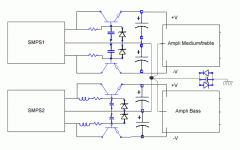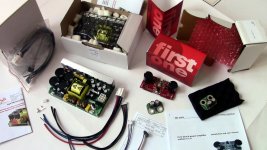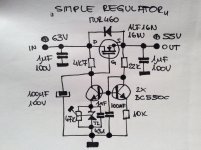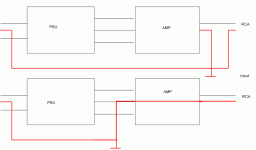Thank you Claude to thinking loud. 🙂Is there then any real benefit of going the cost of 2 SMPS with the First One?
Where does the second SMPS really makes a difference in real life?
There's nothing else but just benefit by using two SMPS instead of one, as an amp is good as its power supply, period. At lower power levels, a watt or few, major benefit comes from being in complete isolation-separation between channels, including and mostly GND. At higher power levels there's benefit from having much more current/power reserve and not to have influence to power supply of the other channel. So at the end all results in better dynamics, separation, more relaxed musical presentation. GND isolation and separation also prevents interferences and thus any kind of unwanted noises.
It's true that good power supply is far from being cheap but you have to look what all has to be included inside to operate properly in long term. Soft start, transformers, energy storage, protections etc., all that has its price. So I don't consider power supplies, especially SMPS1200, to be expensive, it is rather opposite. The truth is the First One is too cheap, so in that context PSU seems expensive.
In reality First One module has a really good price, just look into solid state part of the forum, find similar quality amp schematics and calculate how much would you spent to make one channel of an amp having 26 transistors (one output pair) few IC-s and all together more than 100 RC-s, double sided PCB, not to speak that's assembled and tested.
In whole perspective, summing together all the parts forming dual mono First One amplifier, without any slightest compromise taken, one would get a serious power amplifier for a nice price in a league better than 90% of commercial products.

Cable sets always taken, it spares you time searching, ordering and assembling connectors, what a relief. 😎Hi
For using the hyepx power supplies with the FirstOne amp, do we need the Cable set from hypex?
How are you connecting the amp and power supply?
Thanks
Ani
Not true, the more you separate channels, less through-talk, less influence between channels, the better stereo image. Monoblock amplifiers are the ultimate solution.If we can see the technical benefit, concerning noise and ground loop on this point, we don't, concerning stereo image.

About power supplies, my opinion above. 😉
Thanks for your quick and detailled response Lazy Cat
How much current can one FO 1.4 M module deliver maximum, on peak / short burst (not permanent delivery)?
Thanks as ever
Claude
How much current can one FO 1.4 M module deliver maximum, on peak / short burst (not permanent delivery)?
Thanks as ever
Claude
Andrej, read my lips ;-)Not true, the more you separate channels, less through-talk, less influence between channels, the better stereo image.
It is not about crosstalk. Crosstalk is not an issue (think crosstalk of an instrument between your two ears in real life). It is about "stability" of the image. Instruments precisely localized with space between them. Something like better shaprness in photo when you use a tripod.
A complex phenomena, depending of the place of instruments (mostly in the quarter of the space) little sounds in the trebles on one side, while loud low frequency ones playing on the other side.
Anyway, if the amp has good enough PSRR, as I imagine First one can have with all those active devices ;-) the advantage with the ground loops is obvious in dual mono. Now, the real question is Is-it worth the added price ?
As somebody has offered-me two First one modules witch are right on my table, i will have the opportunity to make some experiments. My project is to use unregulated cheaper SMPS followed by a cap multiplier (with a zener in // with the cap ?). Both to reject ripple an switching frequency leakage. It will be dual, anyway, because active speakers. And to compare with my actual big linear.
I don't understand, with the price of the Hypex SMPS, the lack of technical datas in their sheet. No indication of ripple and noise, no voltage curves VS current ... Bruno ?
My project (See attached, apologize for the poor quality).
Ground is isolated from earth with two diodes, to protect the user against any dangerous electric shock. (0.7V max).
Treble size use film cap in the base to filter HF ripples, and a coil with lytic, on the bass side.
May-be I can use a single SMPS if i chose the same voltages for basses and treble, two if they need to be different. I wonder if a class D amp should be good enough for basses (up to 1KHz).
Comments welcomed.
Ground is isolated from earth with two diodes, to protect the user against any dangerous electric shock. (0.7V max).
Treble size use film cap in the base to filter HF ripples, and a coil with lytic, on the bass side.
May-be I can use a single SMPS if i chose the same voltages for basses and treble, two if they need to be different. I wonder if a class D amp should be good enough for basses (up to 1KHz).
Comments welcomed.
Attachments
Up to now we have Rick's testimony, anyone else? 🙂
We are getting there, waiting for the chassis, and still acquiring hardware, as I can not find everything from one store. I live in a rural town with a population of 9000, so I buy most of this stuff on-line. 🙂 (not many of us audio geeks here)
For using the hyepx power supplies with the FirstOne amp, do we need the Cable set from hypex?
ani101,
As Lazy mentioned, it will make things easier for You. I got the cable set myself, and You will be happy to know that it even comes with the jumper pin to switch the mains voltage to 120. 😀
I Love Lazy's packaging.
Attachments
Yes, I know exactly what you mean. Best imaging with best image stability we got with complete GND isolation, from the chassis and between First One channels. Common GND is and should be at source side only, not at power amp side. Your sch is sub optimal since it repeats common GND causing more interferences and thus poorer image stability.Andrej, read my lips ;-)
It is not about crosstalk. Crosstalk is not an issue (think crosstalk of an instrument between your two ears in real life). It is about "stability" of the image. Instruments precisely localized with space between them. Something like better shaprness in photo when you use a tripod.

Simple positive regulator for you, negative is the same, only change transistors with complements, also change elco and TL431 polarity . 😉
Attachments
As Lazy mentioned, it will make things easier for You. I got the cable set myself, and You will be happy to know that it even comes with the jumper pin to switch the mains voltage to 120. 😀
I Love Lazy's packaging.

L.C.

It's 16 A continuous, no Id peak info in datasheet. Please take a look in attached application note, very simple & nice lateral mosfets practical recommendations.Thanks for your quick and detailled response Lazy Cat
How much current can one FO 1.4 M module deliver maximum, on peak / short burst (not permanent delivery)?
Thanks as ever
Claude
Attachments
Interesting reading, thanks!
Things have moved on a bit since my beloved amp around 2SA1302 bipolars 20y ago, but not the max current in that case 🙂
Understand now why there can't be no peak current as you use "safer/easier" mosfets, very clear, thanks again!
Claude
Things have moved on a bit since my beloved amp around 2SA1302 bipolars 20y ago, but not the max current in that case 🙂
Understand now why there can't be no peak current as you use "safer/easier" mosfets, very clear, thanks again!
Claude
Hi, I cannot remember if the dimensions of the FO "Small" was posted somewhere ?
can you advise please, if the PCB are finished 🙂
can you advise please, if the PCB are finished 🙂
Few pages back (set 50 posts per page) were posted.
First One S - 80 W/8 Ohm, 50 x 60 mm
First One M - 160 W/8 Ohm, 50 x 100 mm
First One L - 240 W/8 Ohm, 50 x 160 mm
S & L in final stage of PCB design. 😉
First One S - 80 W/8 Ohm, 50 x 60 mm
First One M - 160 W/8 Ohm, 50 x 100 mm
First One L - 240 W/8 Ohm, 50 x 160 mm
S & L in final stage of PCB design. 😉
Thanks for your attention, remarks and schematic, Andrej.Common GND is and should be at source side only, not at power amp side.
No loop problem expected for me, here, as I will use CAT 6 FTP cable (single cable for the two channels) from my Digital filter and symmetric input. And I'm not sure, as I said, if I will use a single SMPS or not.
Anyway, in absence of any schematic of your amp, how can-we know if input ground is isolated with a resistance or not from output one ?
I tested on the FO, and, indeed, they are shorten.
That is the kind of things that need to be tested on the bench, as well as the best location to take the chassis earth.
Sub optimal ? I tried a lot of solutions during years and want to keep-it as simple as possible. No complexity needed on my opinion, if it don't bring real audible benefit. My conclusion from those attempts were: Avoid any regulation, simple stabilization (no global loop) sound better. Too, I tend to prefer MOS Fets (like your schematic) with BJT amps, and BJT with MOSFET amps.
Final choice will depend on the SMPS performance and available voltage. (Will try the Cresnet one, less expensive than Hypex).
Too, I will try a regulated SMPS (I have two 75V Connex), to see if, adding such a stabilization between-it and your amp can counter-act the negative effect of the active regulation. I never tried this figure.
Is it worth the try, as, as-you said, an amp can't be better than its power supply.
In fact, the main benefit expected is to protect the amp from any over-voltage, while keeping the V at the limit (60V in this case, according the fact your caps are 63V) under heavy load.
- Filtering more the ripples and switching frequency leaks.
- Adding more capacitance for bass frequencies without charging too much the SMPS during start sequence.
- And avoid any power losses and heat as possible (Reason why I prefer BJT here).
I just noticed a remark from Bruno P. last night, about this kind of add after SMPS, where he said it was sounding a little better than SMPS alone on the bass range. I suppose it was with his UCD class D amps ?
I noticed several remarks from builders of a TSSA amp, telling they preferred Big linear PSU. Will try-it as well, this contradict my previous experiences, but who knows ?
PSU is a way to "voice" an amp, adding more strength to treble side oriented one, or the contrary. And, on this point, using big mono lytics or multiple paralleled ones is a way to fine tune the sound too, depending of the system around.
Last edited:
More thoughts about ground loops.
Lazy Cat is right in this case. The FO is so nicely designed, thanks to SMD and printed board design that the ground paths are ultra short inside-it. No voltage differences to be feared here, whatever the currents.
As the main problem is ground loop from chassis and earths (leakages across trasfos) of various sources connected, it is likely the star ground in this amp will be better if situated right at the input .
But it is not a general law. And there are often situations where star ground have to be taken at the output of the PSU, or is better this way. No choice, by example, with a single PSU. In every case, The RCA ground have to be isolated from the amp's chassis.
A good tip to minimize the loop effects is to do this:
- Remove all the connections between your pieces of equipment and unplug them all from AC. And ensure all chassis are isolated from each others.
- Then connect the preamp to the ac, disconnecting the earth from AC and find the AC sens where the voltage between its chassis (or earth wire from the preamp) and earth of the AC) produce the less voltage.
- Once done, connect the audio link to the power amp, and find the AC sens of the power amp plug that produce the less voltage measuring in the same place (between preamp and AC earth).
- One by one, do the same for all audio chassis you use.
You can change the AC sens in an outlet Strip (multiprise ?), but, you Know what you are doing, don't take any risk of electrocution, don't touch wires or chassis with your skin while you are doing-it.
Once all is done, if you are courageous enough and don't care about guaranties of your new gears, you can add this double reverse diode + caps right between the earth wire and the AC outlet inside each of your equipment parts to reduce further the parasitic signals.
Enjoy now a more transparent and optimized system.
Lazy Cat is right in this case. The FO is so nicely designed, thanks to SMD and printed board design that the ground paths are ultra short inside-it. No voltage differences to be feared here, whatever the currents.
As the main problem is ground loop from chassis and earths (leakages across trasfos) of various sources connected, it is likely the star ground in this amp will be better if situated right at the input .
But it is not a general law. And there are often situations where star ground have to be taken at the output of the PSU, or is better this way. No choice, by example, with a single PSU. In every case, The RCA ground have to be isolated from the amp's chassis.
A good tip to minimize the loop effects is to do this:
- Remove all the connections between your pieces of equipment and unplug them all from AC. And ensure all chassis are isolated from each others.
- Then connect the preamp to the ac, disconnecting the earth from AC and find the AC sens where the voltage between its chassis (or earth wire from the preamp) and earth of the AC) produce the less voltage.
- Once done, connect the audio link to the power amp, and find the AC sens of the power amp plug that produce the less voltage measuring in the same place (between preamp and AC earth).
- One by one, do the same for all audio chassis you use.
You can change the AC sens in an outlet Strip (multiprise ?), but, you Know what you are doing, don't take any risk of electrocution, don't touch wires or chassis with your skin while you are doing-it.
Once all is done, if you are courageous enough and don't care about guaranties of your new gears, you can add this double reverse diode + caps right between the earth wire and the AC outlet inside each of your equipment parts to reduce further the parasitic signals.
Enjoy now a more transparent and optimized system.
Last edited:
Now, if you will use an amp for professional purpose, in dangerous situations like PA systems, star ground at the input is a requisite. (figure1)
Look at what will happens in figure 2 if the earth of the amp, or the source's one is connected accidently to the hot point of the AC (It happened severall time in my life).
The ground track inside the printed board will act as a fuse. Probably a bad event for the preamp too, but, at least, the amp will stay alive in figure 1.
Look at what will happens in figure 2 if the earth of the amp, or the source's one is connected accidently to the hot point of the AC (It happened severall time in my life).
The ground track inside the printed board will act as a fuse. Probably a bad event for the preamp too, but, at least, the amp will stay alive in figure 1.
Attachments
Last edited:
And I'm not sure, as I said, if I will use a single SMPS or not.
Final choice will depend on the SMPS performance and available voltage. (Will try the Cresnet one, less expensive than Hypex).
Too, I will try a regulated SMPS (I have two 75V Connex), to see if, adding such a stabilization between-it and your amp can counter-act the negative effect of the active regulation. I never tried this figure.
- Adding more capacitance for bass frequencies without charging too much the SMPS during start sequence.
Interesting, let us lnow how you progress.
If you look at my posts from yesterday, LC had a point regarding dual mono as that's the layout he prefers. It makes sense re channel separation and noise.
I have though to say, I am personaly less sensitive to "absolute low level floor noise" so personaly not a big fan of dual mono (but I am fan of big PS). In fact, my current conventional amp has all the components for dual mono ( 2 large transformators, many many caps various sizes etc.) but I decided to go for a large überalles PS for both chanels instead of 2 large mono PS. So everything is in parallel and available to both channels, through a big rectifier, even the 2 transformators.
Reason was back then that such a super large PS wouldn't sag "whatever" whereas if a large current was needed on one channel only a mono layout would (well, a bit). Somewhere having a "double PS" available for both channels made more sense to me re current delivery and tension stability. OK, if all channels need current, PS will go (very slightly) down, but then it would be equal (slight voltage drop for both channels, image stable) and at the end a dual mono aswell. So at the end I am not sure one is better off with dual mono than with double PS regarding image stability. This is of course me and my experience, well noting conventional PS, not SMPS (never used them so far)
As said, where LC has a point is on noise floor/ separate grounds and also dual mono allows amps closer to the LS etc., so dual mono can't harm.
Having said that, the Hypex SMPS are expensive, although of course I wouldn't want to drop quality. Trying to adress your comments, I believe it would be very interesting to see how a First One performs with 2x SMPS 1200 (costly!) vs a First One with 1x SMPS 3K. The lastest is just a tad more expensive than 1 x SMPS 1200 but seems to be able to deliver a lot of current, fast, without voltage drop. And it is still a Hypex product with, I guess, all the goodies (protection, quality, softstart etc.) that come with the recommended SMPS. Perhaps that is the best of both world: super stable PS while more affordable than 2x smaller SMPS?
I don't know if anyone tried this SMPS 3K together with the FO?
Thinking loud again, sorry if reharshing stuff that has been tried or said already
Claude
I have tested Cresnet's SMPS and they're really good, input and output caps are also good quality.
Thanks
Do
Thanks
Do
- Home
- Vendor's Bazaar
- First One - mosFET amplifier module



